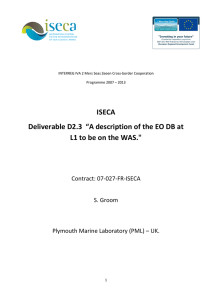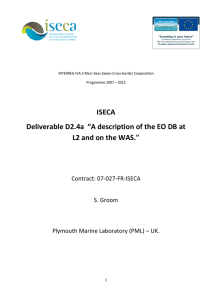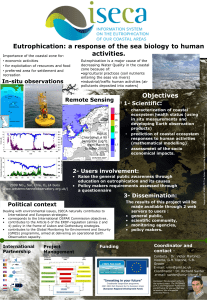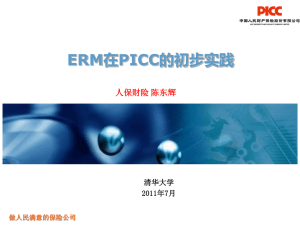PMLs: A direct approach Please share
advertisement
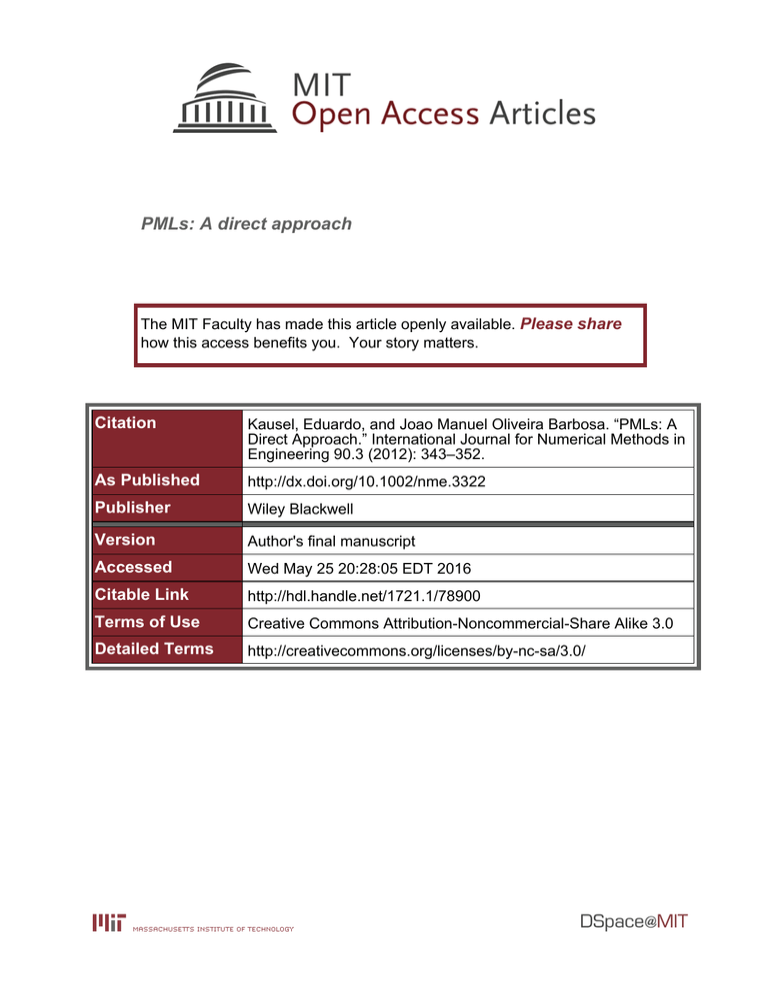
PMLs: A direct approach The MIT Faculty has made this article openly available. Please share how this access benefits you. Your story matters. Citation Kausel, Eduardo, and Joao Manuel Oliveira Barbosa. “PMLs: A Direct Approach.” International Journal for Numerical Methods in Engineering 90.3 (2012): 343–352. As Published http://dx.doi.org/10.1002/nme.3322 Publisher Wiley Blackwell Version Author's final manuscript Accessed Wed May 25 20:28:05 EDT 2016 Citable Link http://hdl.handle.net/1721.1/78900 Terms of Use Creative Commons Attribution-Noncommercial-Share Alike 3.0 Detailed Terms http://creativecommons.org/licenses/by-nc-sa/3.0/ International Journal of Numerical Methods in Engineering, 2012; 90, 343–352 PMLs: A direct approach by Eduardo Kausel1 João Manuel de Oliveira Barbosa2 Abstract This brief article outlines a new and rather simple method for obtaining the finite element matrices for a Perfectly Matched Layer (PML) used for elastic wave propagation in the context of a frequency-domain formulation. For this purpose, we introduce a fairly mild simplification which allows applying the stretching functions directly to the mass and stiffness matrices obtained via conventional methods (i.e. elastic elements), a novel strategy that allows circumventing the use of integration via Gaussian quadrature. In essence, the technique proposed herein is equivalent to a direct application of the method of weighted residuals in stretched space, followed by a conversion of the linear dimensions into position-dependent complex-values. Most importantly, numerical tests demonstrate that the technique does work as intended, and in fact, splendidly so. 1. Introduction In a nutshell, the Perfectly Matched Layer (PML) is a numerical technique used for purposes similar to those of absorbing or transmitting boundaries [12], namely to suppress undesirable echoes and reflections of waves when models of infinite media are cast with discrete, finite models [1-10,14-17]. These numerical devices are based on stretching one or more coordinates by means of appropriate complex-valued, space-dependent functions which are designed so that the waves penetrate the PML without sensing any change in mechanical impedance, as a result of which the waves are completely absorbed and disappear into the PML. Since their introduction by Bérenger in 1994 [3], PMLs have been found so effective in the avoidance of the box effect that they have become the method of choice —at least among researchers dealing with electromagnetic waves. Conceivably, PMLs may also yet supplant and supersede the paraxial boundaries which until quite recently reigned supreme in the simulation of elastic wave propagation within unbounded domains. A possible exception to this may be the Boundary Element Method, which inasmuch it can deal with such domains with great effectiveness and for quite variable configurations, will continue to find widespread use in years to come. 2. PMLs and viscoelastic anisotropy A fair number of modern papers on PMLs for elastic waves affirm that stretching of the coordinates is equivalent to some form of viscoelastic anisotropy. However, although PMLs do indeed exhibit anisotropic characteristics by their very construction, a more careful analysis demonstrates that there is no anisotropic, viscoelastic material which satisfies the transformation of coordinates, i.e. the transformed equations do not obey the equations of elastodynamics, not even if the scaled medium is initially isotropic and stretching is confined to a single coordinate direction. Moreover, although several well-known papers on the subject have previously observed on the failure of symmetry in the stretching transformation, their authors have then proceeded to ignore that fact as if all continued to be well. For example, Zheng and Huang 1 2 Professor of Civil and Environmental Engineering, Massachusetts Institute of Technology, Cambridge, MA 02139 Doctoral Candidate, Department of Civil Engineering, University of Oporto, Portugal. Visiting student at MIT 1 (2002) [17] first observe that “the anisotropic PML formulation requires that the waves in the PML are still governed by the equation of motion and Hooke’s law… That means the properties of the material can be modified, but not the physical principles behind the governing equations”. They then go on to say that “in this artificial anisotropic absorptive material, the stress tensor is no longer symmetric”, yet later on in section 4.1 proceed to derive the numerical PML by invocation of the “principle of minimum potential energy”. Clearly, if the stress tensor is not symmetric, then stresses fail rotational equilibrium and the principle of virtual work ceases to be valid. Similarly, Harari and Albocher (2006) [8] state in their section 3.1 that “the modified tensor loses the two minor symmetries which may be interpreted in the layer as having a nonsymmetric stress tensor …”, but then go on with their formulation without ever looking back again. This seems peculiar indeed, for if the stretched stresses fail equilibrium, then none of the classical theorems of elasticity which underpin the finite element method —for example, the principle of virtual work— can be assumed without much ado to remain strictly valid for PMLs. Now, it can readily be shown that the loss of the minor symmetries implies that there is no anisotropic material which matches the PML properties, not even if stretching is confined to a single direction. This means in turn that the stretched equations cannot be interpreted as equations of viscoelasticity, and with that, the whole mathematical edifice based on the theory of elasticity breaks down, e.g. energy principles, thermodynamic considerations, and so forth. Hence, a PML is a purely mathematical device, not a physical one, although it does indeed absorb waves as intended, and then again is very good at that. On a related matter, we should add that Milton et al (2006) recently showed that the ordinary equations of linear elastic media are not invariant under coordinate transformation, no matter what transformation is applied to the materials. Instead, one has to look at a more general class of wave equations. Granted, the applicability of the method of weighted residuals in the context of PMLs does not depend on the validity of the principle of virtual work in the first place, since it can be used for any differential equation, even for those which in conjunction with their boundary conditions may not be self-adjoint. In addition, it may well be that PML authors have used the term “anisotropic” in a rather loose sense, without necessarily implying a strict mapping onto viscoelastic materials with space– and orientation dependent properties. Still, the fact that some well-known authors may have invoked the principle of minimum potential energy in the first place while some others may have referred to material anisotropy rather informally suggest that these concepts may be confusing not only to the uninitiated, but also those conversant in the subject area, even if both of these concepts are ultimately irrelevant to the formulation of PMLs and their performance as absorbing devices. In the ensuing pages we deviate somewhat from the conventional approach to PMLs which casts the stretched equations of motion in the context of a weighted residuals formulation together with Gaussian quadrature. Instead, we proceed to derive the finite element matrices for a PML directly in stretched space, which results in a simple transformation of the element’s physical linear dimensions into a complex counterpart. This has the advantage that many elements among the vast library of existing finite elements can readily be adapted for use as PMLs, provided that their characteristic matrices are known explicitly either in terms of the element’s linear dimensions or in terms of the coordinates of its nodes, and that these can in turn readily be associated with the stretched coordinates. We show that this procedure works just as well as the classical approach, and also suggest some other possible applications. To the best of our 2 knowledge, this ad hoc, simple approach has not been proposed before, even if in retrospect it may appear to be obvious. 3. Finite elements for SH waves Consider a laterally homogeneous elastic half-space in anti-plane strain (i.e. subjected to SH waves) for which one seeks to develop a PML of finite depth. This numerical device will absorb all waves in the downward vertical direction, say z , so this will also be the direction of stretching. Hence, this changes the natural (or physical) coordinate z into the stretched coordinate z . In the absence of sources within the half-space, the equation of motion in stretched space is 2u 2u u G G t 2 x 2 z z (3.1) with being the mass density and G the shear modulus. Both the stretched and natural coordinates are related by a complex-valued, nowhere zero stretching function z z z which satisfies the following properties: z z s ds z z , z z 0 d z dz , dz dz d 1 d dz z dz (3.2) Thus, the equation of motion can also be written in physical coordinates as 2u 2 u G u G 2 0 2 x z z z t z (3.3) Step 1: Vertical (initial) discretization Assume that the PML is discretized into finite elements, but to simplify matters, at first focus attention solely on the discretization in the vertical z direction, and postpone for now the discretization in the horizontal direction, along which the system remains continuous in both space and time. Consider then a vertically finite region (i.e. a thin layer, which later on will contain a single row of finite elements) within which we describe the motions by means of interpolation functions of arbitrary order: u x, z , t N z U x , t (3.4) in which N is a row vector of interpolation functions, and U is a column vector of “nodal” displacement functions. For example, for linear and quadratic expansions, N 1 where , and N (1 )(1 2 ) 4 (1 ) (2 1) z z j 1 (3.5) (3.6) z j z j 1 3 in which j 1, 2, is the layer number, counted from the surface of the PML (i.e. the interface to the elastic region), and z0 , z1 , are the layer horizons (or “nodal surfaces”) , counted positive down. Application of the principle of weighted residuals in its weak form will then lead to the thin layer equation (i.e. the equation for a single thin layer or “element” in the PML) [11] Mj 2U 2U G j U Pj A j t 2 x 2 (3.7) where Mj zj z j 1 G NT N dz z j 1 z z z zj NT N z dz , A j G NT N z dz , G j z j 1 zj (3.8) and P j P j x, t contains the consistent shearing tractions at the upper and lower horizon of the thin layer, which are analogous to nodal forces in a conventional finite element. In the absence of external sources, and being these tractions a manifestation of the internal shearing stresses at the interfaces of the thin layer, they will be equilibrated by the equal and opposite tractions acting on neighboring thin layers which then cancel during the assembly of the system equation, in which case P j can safely be ignored in the context of this paper. Now, for a formulation cast in the frequency domain, a widely used stretching function is of the form (e.g. Collino and Tsogka, 2001 [6]) z 1 i z z, , z o z H m (3.9) in which 0 is an appropriate constant, H is the total depth of the PML, m 1, 2, is an arbitrary integer power , and z is measured perpendicularly from a point on the surface where the PML begins, i.e. from the interface with the elastic region. Hence z z s ds z i z z , z 0 and z z, z s, ds z 0 z z j 1 z z j 1 i z z, z z j 1 , (3.10) (3.11) So here is the approximation: In the same spirit of those conventional finite elements where the spatial variation of the material properties within an element is neglected, we proceed to neglect in the interpolation functions the local variation of the imaginary part z , i.e. we make the ansatz z z j 1 z j z j 1 z z j 1 z j z j 1 (3.12) with z j z j 1 Lzj being the stretched depth of the element. It follows that N N N (3.13) 4 and since z dz dz , then Mj zj z j 1 zj NT N z dz NT N dz (3.14a) z j 1 zj zj z j 1 z j 1 A j G NT N z dz G NT N dz (3.14b) zj zj 1 NT 1 N G NT N NT N dz G dz z dz G z j 1 z j 1 z j 1 z z z z z z z z z Gj zj (3.14c) We observe that the thin-layer matrices are now identical to the matrices obtained for an elastic layer, except that they are stretched. Hence, all one needs to do is replace in the classical TLM formulation the depths of the thin layers by their complex, space-dependent, stretched counterparts. This is equivalent to assuming that one can apply the method of weighted residuals directly in stretched space as if it were elastic. For example, for a linear expansion, these matrices are found to be Mj with Lzj 2 1 , 6 1 2 Aj GLzj 2 1 , 6 1 2 Gj Lzj z j z j 1 z z j z z j 1 z j z j 1 i z z j z z j 1 G Lzj 1 1 1 1 (3.15) (3.16) Clearly, PMLs are perfect absorbers only if one is able to solve the exact, continuous wave equations with complex moduli, but any PML begins to elicit at least some wave reflections as soon as one discretizes the equations of motion (Johnson, 2010, [10]). Thus, one of the requirements for the attainment of near perfect absorption characteristics is to utilize a PML grid whose properties and stretching functions vary slowly from element to element, and if that is the case, then the assumption of constant properties within any element is a very good one indeed. Moreover, the very reason why the PML is inhomogeneous to begin with is to combat discretization errors. In the absence of discretization, even a step function (i.e a PML with m 0 ) would be reflectionless. Discretization breaks this property, so one falls back on the “adiabatic theorem”: any material change in a wave equation, if it is made gradual enough, will be reflectionless (Oskooi et al, 2008 [16]) . In our case the same situation holds true: all that matters is for the parameters to change gradually. Step 2: Horizontal (complete two-dimensional) discretization We proceed next to carry out the necessary additional discretization in the horizontal direction x which may (or not) be modified by another stretching function x . It will then be found that the interpolation and integration in that direction involves appropriate combinations of the matrices in the previous section that will leave the complex factor (or divisor) Lzj unaffected, producing instead additional terms with factor (or divisor) Lxk , namely the lateral width —perhaps also stretched— of the element, where the subindex k identifies the element’s horizontal position. For example, in the case of a rectangular mesh with four-noded quadrilaterals based on a linear expansion in both x, z and where the nodes are numbered top-left, bottom-left, top-right and 5 bottom-right, the mass and stiffness matrices for an element contained in the jth thin layer and k th column are found to be L 2M j M xk 6 Mj K 1 Lxk Aj A j G Lzj 6 Lxk 4 2 2 Mj Lxk Lzj 2 4 1 2M j 36 2 1 4 1 2 2 A j Lxk 2G j G j A j 6 G j 2G j 1 2 2 4 1 2 1 1 1 2 2 2 1 2 1 2 2 2 1 1 Lxk 1 Lzj 1 1 2 2 2 1 2 1 2 1 1 2 2 1 2 (3.17a) (3.17b) which agree perfectly with the classical formulation for a linear, isoparametric, rectangular element in anti-plane shear, except for the non-physical meaning of the now stretched dimensions Lxk , Lzj . Very similar results apply to the mass and stiffness matrices of other isoparametric elements based on both linear and quadratic interpolation functions. Inasmuch as these are well known, their expressions can be omitted herein. 4. Finite elements for SVP waves When the previous ansatz is applied to the in-plane (i.e. plane-strain) components of motion involving coupled shear and dilatational waves (i.e. the vector wave equation), very similar results are obtained, except that the formulation includes now twice as many degrees of freedom and yields additional thin layer matrices. Although the developments are now both lengthier and more complicated, ultimately one arrives at element matrices which are identical to those for a classical viscoelastic material, except that the linear dimensions in the directions of stretching are now both complex-valued and space-dependent. Hence, inasmuch as the method is valid for both SH and SVP waves, this means also that the method can just as well be applied to the threedimensional wave equation, because it is always possible to express any displacement field in a homogeneous medium by superposition of plane waves in all directions. Thus, no additional insight on the subject matter at hand will be gained by treating these cases in detail herein, so in the interest of brevity and conciseness, we omit them altogether. 5. Examples By now some readers might well agree that the present PML formulation is indeed simpler—and perhaps even obvious— but they will also wonder if this procedure works in a satisfactory manner. The answer is an emphatic yes, it works splendidly well, as we shall demonstrate by means of two canonical problems for which closed form solutions are available. 6 Example 1: SH source at surface of an elastic half-space Consider an elastic half-space of mass density , shear modulus G , and shear wave velocity CS subjected to an anti-plane, harmonic SH line source at the origin of coordinates on the free surface. We model this problem by means of three PMLs joined together as shown in Fig. 1. The central PML is stretched vertically while the two lateral PMLs are stretched in both their horizontal and vertical directions. The width and depth of each PML is taken equal to twice the shear wavelength, i.e. S 2 / k 2 CS / . The parameters used in the simulation are: 2 rad/s, CS 1 , i.e. S 1 , and for z in formula 3.9 , m 2 , H 2S 2 , 0 10 . Figure 1: Sketch of PML geometry In principle, one half of this model would have been sufficient, but we wished to demonstrate that the PML works just as well in either horizontal direction. On the free surface, this problem admits the exact solution (Kausel, 2006, p. 69 ) [13] u y x,0, x 1 H 0 2 2iG CS (5.1) in which H 0 2 is the second Hankel function of order zero. At first, we proceeded to subdivide each of the PMLs into a regular mesh of nine-noded, quadratic, isoparametric finite elements, using five such elements per wavelength, i.e. each PML contained 10 10 elements, each of which was stretched as described earlier. This fairly coarse mesh already provided excellent results, but returned displacements at the surface of the core PML which were too far apart for a satisfactory graphical comparison with the theoretical solution. We then increased the number of columns —but not the rows— of the central PML to 100 while leaving the lateral PMLs untouched, which increased substantially the horizontal resolution while diminishing the numerical dispersion. Although in this model the core elements had rather skinny horizontal-to-vertical aspect ratios of 1:10, the results were spectacular: Along 7 the free surface, and within the core region, the computed displacements became indistinguishable from the exact solution, as will be seen in the ensuing. 1.2 RE(uyy) - FE+PML 1 IM(uyy) - FE + PML RE(uyy) - Theor. 0.8 IM(uyy) - Theor. uyy [m] 0.6 0.4 0.2 0 -0.2 -0.4 -0.6 -3 -2 -1 0 1 2 3 Abscissa of receiver [m] Figure 2: Displacements on the surface 1.2 RE(uyy) - FE + PML 1 IM(uyy) - FE + PML RE(uyy) - Theor. 0.8 IM(uyy) - Theor. RE(uyy) - Gauss. Quad. 0.6 uyy [m] IM(uyy) - Gauss. Quad. 0.4 0.2 0 -0.2 -0.4 -0.6 0 0.1 0.2 0.3 0.4 0.5 0.6 0.7 0.8 0.9 1 Abscissa of receiver [m] Figure 3: Close-up of response by current and classical methods Fig. 2 shows a comparison of the computed displacements against the exact solution. The region with abscissas in the range 1 1 corresponds to the core PML, while the remainder is in the lateral PMLs. As can be seen, in the core region the numerical and theoretical solutions are identical, while in the lateral PMLs, the numerical solution dies out before reaching the stiff lateral boundaries —as expected. The theoretical solution, of course, does not die out. Fig. 3, on the other hand, shows a close-up of the same problem, but this time computed with both the current method and with the classical PML approach with the same parameters and grid, 8 and using for the latter a Gaussian quadrature scheme of 10 10 points, which is far more than necessary. As can be seen, the current approach and the classical approach coincide with each other, and both are virtually the same as the exact solution. 0.5 RE(uxx) - FE + PML IM(uxx) - FE + PM 0.4 RE(uxx) - Theor. IM(uxx) - Theor. uxx [m] 0.3 0.2 0.1 0 -0.1 -0.2 -3 -2 -1 0 1 2 3 Abscissa of receiver [m] Figure 4: Horizontal displacement due to horizontal load in full space, z 0 , 0.25 Example 2: Full space subjected to SVP line source To demonstrate that the method works just as well for SVP sources, we consider next the problem of a homogeneous full space subjected to an in-plane, harmonic line source. This is the classical Stokes problem in two dimensions for which the exact solution is (Kausel, 2006, p. 38): uij x, z , 1 ij i j , G i , j x, z (5.2a) 2 i H1(2) ( S ) H1(2) ( P ) (2) H 0 ( S ) P 4 S (5.2b) 2 i (2) H 2 ( P ) H 2(2) ( S ) 4 (5.2c) where ij is the Kronecker delta (1 if i j , and zero otherwise), S r / CS , P r / CP , r is the radial distance, CP is the P-wave velocity, i , j are the direction cosines of the radial line to the receiver, and the H1 2 , H 2 2 are second Hankel functions of order 1 and 2, respectively. For receivers placed in the horizontal plane z 0 , r x and x sgn x , z 0 , in which case the only two non-zero components are 9 u xx x,0, 1 , G u zz x,0, 1 G (5.3) 0.5 RE(uzz) - FE + PML IM(uzz) - FE + PML 0.4 RE(uzz) - Theor. IM(uzz) - Theor. uzz [m] 0.3 0.2 0.1 0 -0.1 -0.2 -3 -2 -1 0 1 2 3 Abscissa of receiver [m] Figure 5: Vertical displacement due to vertical load in full space, z 0 , 0.25 To model this problem with three PML’s as in Fig. 1, we make use of symmetry considerations, dividing the external load by two and restraining the vertical DOFs at the surface for a horizontal load (i.e. horizontal rollers), and the horizontal DOFs for a vertical load (i.e. vertical rollers). The parameters are as in the previous example, taking also a Poisson’s ratio 0.25 , i.e. CP CS 3 . Figs. 4 and 5 depict u xx , u zz i.e. the horizontal displacement due to a horizontal load, and the vertical displacement due to a vertical load. As can be seen, the agreement with the exact solution is once again superb. Moreover, while we might have needed choosing a larger depth for the PMLs to accommodate the longer wavelength of P waves, we obtained similarly good results with the same mesh with Poisson’s ratio as high as 0.4. Hence, the proposed method not only works as intended, but does so very well indeed. An enlarged view of the comparison with the classical approach yields results qualitatively similar to those for the anti-plane case in Fig. 3, so the corresponding figures need not be shown. 6. Additional applications In the light of the excellent performance of the proposed method together with its great ease of use, it would seem that it could readily be adopted for other types of PMLs, say cylindrical or spherical sectors modeled with either linear or quadratic elements. It suffices to use the known stiffness and mass matrices listed in numerous books on finite elements, and merely change the linear dimensions of these elements into position-dependent, complex values before assembling the global matrices. Moreover, it should also be possible to consider elements that are not aligned with the coordinate directions, provided that the stiffness and mass properties can be expressed in terms of the element’s nodal coordinates, which are then stretched as previously described. The writers have already verified the applicability of the method described to 10 cylindrical coordinates and will document these together with miscellaneous other applications in a separate article. These will demonstrate the superb accuracy that one can achieve with such PMLs in the context of problems of practical significance. Another relevant issue may be how well the proposed method copes with shallow waves of grazing angles of incidence. In this respect, we have already achieved very good preliminary results to be described in our forthcoming publication, but the reader may already ponder about the fact that in both examples shown, the dynamic line sources —which are wavenumber white— were placed right at the surface of the PML. Thus, the displacements depicted in these figures results mainly from waves traveling parallel to the surface that make up the bulk of the response computed. 7. Conclusions The approximation proposed herein is equivalent to the assumption that one can apply the method of weighted residuals directly in stretched space, which then results in classical stiffness and mass matrices which contain the stretched linear dimensions of the elements as factors and divisors. In essence what we are doing is assume that the stretched material properties are constant within an element, and since that element is small in comparison with both the wavelengths that pass through it and the rate of change of the stretching functions, all is well. It suffices then to take the classical finite elements available in the literature and express their physical dimensions in terms of appropriate position-dependent, complex values. Moreover, this applies not only to the Cartesian reference frame considered in this paper, but also to cylindrical and/or spherical PML domains. To a casual reader and with the benefit of hindsight, this ad hoc and admittedly simple method might appear to be obvious, but to the best of the writers’ knowledge this concept had not been proposed before. In the examples considered herein our technique gave results which coincided with classical technique based on Gaussian quadrature, and both were virtually exact. In the light of the very positive results attained herein, we are confident that the performance and outstanding qualities of this simple approach will be confirmed by others. Indeed, what ultimately really matters is the performance of the PML as a wave-absorbing device, and in that regard, the proposed strategy passes with flying colors. Acknowledgement The second author wishes to thank the financial support he received from the Fundação para a Ciência e a Tecnologia of Portugal (FCT ) through grant number SFRH/BD/47724/2008. He also wishes to thank his academic advisors Prof. Rui Calçada and Prof. Álvaro Azevedo of the University of Oporto for arranging his traineeship at MIT as a visiting student under the umbrella of the MIT-Portugal Program. 11 References 1. Basu, U. and Chopra, A.K. (2003): “Perfectly matched layers for time-harmonic elastodynamics of unbounded domains: theory and finite element implementation”, Computer Methods in Applied Mechanics and Engineering, 192(11-12):1337-1375 2. Basu, U. and Chopra, A.K. (2004): “Perfectly matched layers for transient elastodynamics of unbounded domains”, International Journal for Numerical Methods in Engineering, 59:10391074. See also Erratum: IJNME 2004; 61(1):156-157. 3. Bérenger, JP (1994): “A perfectly matched layer for the absorption of electromagnetic waves”, Journal of Computational Physics, 114(2):185-200. 4. Bielak, J. et al (2010), “The shake-out earthquake scenario: Verification of three simulation sets, Geophysical Journal International 180, 375-404 5. Chew, W. and Liu, Q.H. (1996): “Three-dimensional perfectly matched layer for elastodynamics: a new absorbing boundary condition”, Journal of Computational Acoustics, 4, 341-359 6. Collino, F. and Tsogka, Ch. (2001): Application of the perfectly matched absorbing layer model to the linear elastodynamic problem in anisotropic heterogeneous media”, Geophysics, 66(1):294307. 7. Festa, G. and Nielsen, S. (2003): “PML absorbing boundaries”, Bulletin of the Seismological Society of America, 93(2):891-903. 8. Harari, I. and Albocher, U. (2006): “Studies of FE/PML for exterior problems of time-harmonic elastic waves”, Comput. Meth. Appl. Mech. Engrg., 195, 3854-3879. 9. Hastings, F.D., Schneider J.B., and Broschat S.L., (1996) “Application of the perfectly matched layer (PML) absorbing boundary condition to elastic wave propagation”, J. Acoust. Soc. Am., 100 (5): 3061-3069. 10. Johnson, S. G. (2010): “Notes on Perfectly Matched Layers”, Lecture notes, Department of Mathematics, Massachusetts Institute of Technology, downloadable from: http://math.mit.edu/~stevenj/18.369/pml.pdf 11. Kausel, E. (1986): “Wave Propagation in Anisotropic Layered Media”, International Journal for Numerical Methods in Engineering, 23:1567 1578. 12. Kausel, E. (1988): “Local Transmitting Boundaries”, Journal of Engineering Mechanics, ASCE, 114-(6):1011-1027. 13. Kausel, E. (2006): Fundamental Solutions in Elastodynamics: A Compendium, Cambridge University Press, Cambridge, UK. See also the brief Corrigendum together with an extensive Addendum at the following Internet address: “http://www.mit.edu/afs/athena.mit.edu/user/k/a/kausel/Public/webroot/articles/Green Functions/Fundamental Solutions, Corrigendum.pdf” 14. Komatitsch, D. and Tromp, J. (2003): “A perfectly matched layer absorbing boundary condition for the second-order seismic wave equation”, Geophysical Journal International 154, 146–153 15. Milton, G.W., Briane, M. and Willis, J.R. (2006), “On cloaking for elasticity and physical equations with a transformation invariant form”, New Journal of Physics, 8 248, available online at http://iopscience.iop.org/1367-2630/8/10/248 16. Oskoii A. F., Zhang, L. Avniel, Y. and Johnson, S.G. (2008): “The failure of perfectly matched layers, and towards their redemption by adiabatic absorbers”, Optics Express 16 (15), available online at http://www.opticsinfobase.org/abstract.cfm?URI=oe-16-15-11376 17. Zheng, Y. and Huang, X., (2002): “Anisotropic perfectly matched layers for elastic waves in Cartesian and curvilinear coordinates”, Earth Resources Laboratory 2002 Industry Consortium Meeting, Dept. of Earth, Atmospheric, and Planetary Sciences, Massachusetts Institute of Technology (MIT). 12
